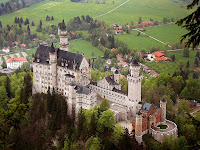Neuschwanstein Castle is a Bavarian palace built in nineteenth century on a rocky hill next to Hohenschwangau and Fussen in southwest Bavaria, Germany. The palace was commissioned by Ludwig II of Bavaria as a retreat and as homage to Richard Wagner, the King's inspiring muse. The photos of the interior is not allowed, it is the most photographed building in Germany and is one of the country's most popular tourist destinations. Ludwig himself named it Neue Hohenschwangau and the name Neuschwanstein was coined after his death.
 The reclusive Ludwig did not allow visitors to his castles, which he intended as personal refuges, but after his death in 1886 the castle was opened to the public. More than 50 million people have visited the Neuschwanstein Castle. About 1.3 million people visit annually, with up to 6,000 per day in the summer. The palace has appeared in several movies, and was the inspiration for Sleeping Beauty Castle at both Disneyland Park and Hong Kong Disneyland. The Free State of Bavaria has spent more than 14.5 million Euros on Neuschwanstein preservation, restoration and tourist services since 1990.
The reclusive Ludwig did not allow visitors to his castles, which he intended as personal refuges, but after his death in 1886 the castle was opened to the public. More than 50 million people have visited the Neuschwanstein Castle. About 1.3 million people visit annually, with up to 6,000 per day in the summer. The palace has appeared in several movies, and was the inspiration for Sleeping Beauty Castle at both Disneyland Park and Hong Kong Disneyland. The Free State of Bavaria has spent more than 14.5 million Euros on Neuschwanstein preservation, restoration and tourist services since 1990.The foundation stone of the building was laid September 5, 1869. Neuschwanstein was designed by Christian Jank, a theatrical set designer, rather than an architect, which says much regarding Ludwig's intentions and explains much of the fantastical nature of the resulting building. The architectural expertise, vital to a building in such a perilous site, was provided first by the Munich court architect Eduard Riedel and later by Georg Dollmann, son-in-law of Leo von Klenze.

 The palace was originally called New Hohenschwangau Castle until the king's death, when it was renamed Neuschwanstein, the castle of the Swan Knight Lohengrin, of Wagner's opera of the same name. In origin, the palace has been the Schwanstein, the seat of the knights of Schwangau, whose emblem had been the swan.
The palace was originally called New Hohenschwangau Castle until the king's death, when it was renamed Neuschwanstein, the castle of the Swan Knight Lohengrin, of Wagner's opera of the same name. In origin, the palace has been the Schwanstein, the seat of the knights of Schwangau, whose emblem had been the swan.The palace comprises a gatehouse, a Tower, the Knight's House with a square tower, and a Palas, or citadel, with two towers to the Western end. The effect of the whole is highly theatrical, both externally and internally. The king's influence is apparent throughout, and he took a keen personal interest in the design and decoration.







No comments:
Post a Comment